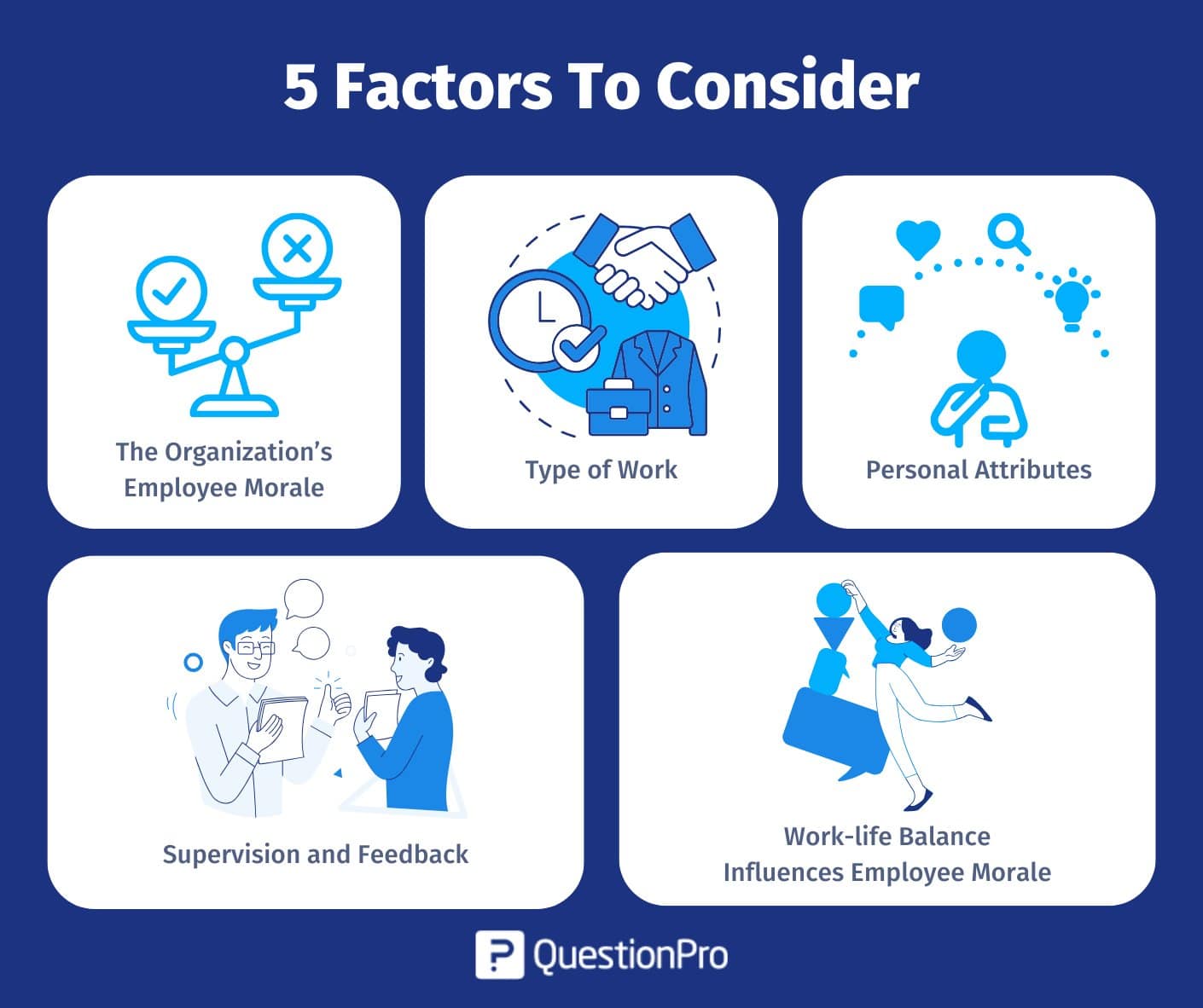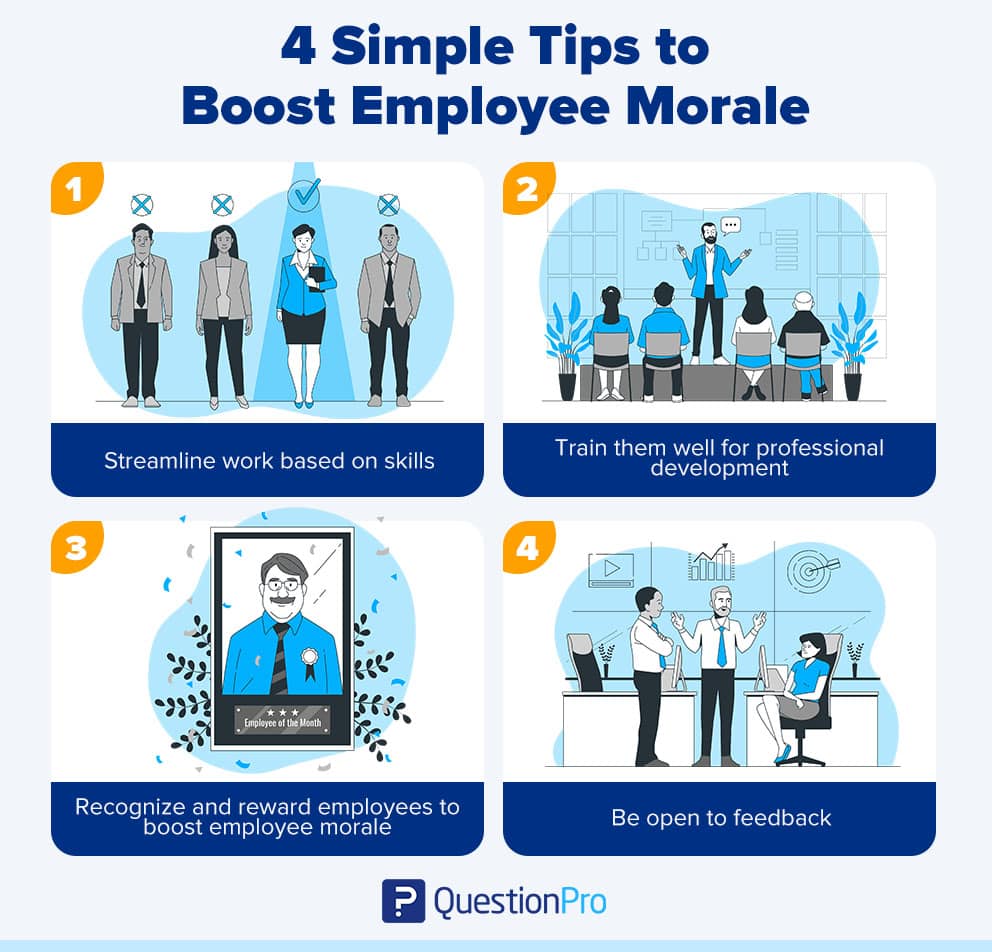
Employee morale is critical to organizational success. It influences productivity, engagement, and overall workplace satisfaction. It reflects employees’ attitudes and feelings toward their jobs and the company culture.
High morale creates a sense of belonging and encourages teamwork, ultimately driving business success. However, when morale dips, it can lead to dissatisfaction, low productivity, and higher turnover rates. It is no secret that employees with good morale levels have a better perspective regarding their work.
They feel more secure in their role, inspiring them to work hard and accomplish more as a team. They have a shared vision and know teamwork is the best way to ensure their company’s long-term success. After all, happy employees want your company to thrive.
In this blog, we will explore the definition of employee morale, the key factors that influence it, and practical strategies to boost morale in the workplace.
What is Employee Morale?
Employee morale is employees’ attitude, satisfaction, and overall outlook when associating with an organization or a business. If your organization has a poor culture, there will be adverse effects like low productivity, low employee satisfaction, etc. It can most certainly lead to greater employee attrition, just to begin with.
Organizations can create a thriving environment where everyone can succeed by understanding and prioritizing employee morale.
Importance of Employee Morale
Employee morale is important because it’s linked directly to employee engagement, job satisfaction, retention, and overall productivity. With good employee morale, employees are more likely to be engaged, more productive, and have a better quality of life. Low employee morale limits productivity and can affect employees’ health and well-being.
- Productivity: High morale often leads to higher productivity, as motivated employees are more focused and efficient.
- Retention: Organizations with high morale tend to retain employees longer, reducing recruitment and training costs associated with high turnover.
- Quality of Work: Engaged employees will likely produce higher-quality work, enhancing overall organizational performance.
- Positive Culture: High morale contributes to a positive organizational culture, fostering teamwork, collaboration, and innovation.
- Customer Satisfaction: Employees with high morale often provide better customer service, leading to increased customer satisfaction and loyalty.
5 Factors to Consider Before Improving Employee Morale
Employee morale is a complex phenomenon and depends on various factors. Here is the different criterion that affects employee morale:

1. The organization’s employee morale:
While it may sound surprising, the organization is one of the biggest and most important factors affecting employee morale. An organization influences an employee’s attitude toward his/her work. An organization’s corporate reputation can undoubtedly build up for better or worse, depending on an employee’s attitude toward it.
2. Type of work:
The nature of work an employee performs at his/her workplace is also greatly responsible for determining morale. An unorganized organizational structure can make situations worse for an employee, affecting employees. If the employee feels that he/she is just a cog machine in a factory line instead of a real person, this, too, may adversely affect their morale.
3. Personal attributes:
Mental and physical health play an important role in determining employee morale. Other important factors that concern employees’ progress and, in turn, their morale are age, education qualification, years of experience, occupational levels, reward perception, and similar factors.
4. Supervision and feedback:
The level of supervision an employee receives is a tremendous factor that affects morale. Suppose the employees feel they lack direction or don’t understand the organizational goals and commitments. In that case, it is the job of the superiors and the leadership in the organization to get them on the same page. But there should not be too much interference, too. If the employees are free to work, their morale will be high.
5. Work-life balance influences employee morale:
Most organizations need to recognize the importance of a healthy work-life balance. The employees must have some activities to relax while they are at work. It’s not just about the foosball culture or an inventory stuffed with food. Forbes magazine emphasizes the importance of maintaining a balanced lifestyle for employees to increase productivity and boost levels of employee satisfaction.
Do you need ideas on how to put together your work environment evaluation survey? Then we recommend you read:
15 Employee Morale Survey Questions You Need to Ask Your Employees
How Can You Measure Employee Morale?
Measuring employee morale is essential to understanding how employees feel about their work environment and identifying areas for improvement. Here are several effective methods for assessing employee morale:
1. Employee Surveys
- Pulse Surveys: Short, frequent surveys that track employee morale over time by asking about their satisfaction, engagement, and overall sentiment.
- Annual Employee Engagement Surveys: More comprehensive surveys that delve into various aspects of work life, such as job satisfaction, management relationships, and workplace culture.
- Morale-specific Surveys: Surveys focus on factors like work-life balance, communication, team dynamics, and recognition.
2. One-on-One Meetings
Regular check-ins between employees and managers provide an opportunity to discuss concerns, achievements, and overall well-being. These conversations give insight into employees’ mental and emotional states.
3. Employee Feedback Platforms
Utilizing tools that allow employees to give continuous feedback on their work environment, team collaboration, and management can help gauge morale in real-time. Anonymous feedback options often lead to more honest responses.
4. Turnover Rates
Monitoring employee retention rates and exit interviews can be a strong indicator of morale. High turnover or common negative feedback during exit interviews can signal underlying morale issues.
5. Absenteeism and Productivity Levels
Low morale often manifests in frequent absenteeism, tardiness, and decreased productivity. Tracking these metrics can help reveal morale trends within teams or departments.
6. Social Interactions and Team Dynamics
Observing how employees interact with each other can provide valuable insight. A collaborative, supportive work environment often indicates higher morale, while tension and poor communication suggest morale problems.
By using a combination of these methods, organizations can clearly see employee morale and take action to address any concerns.
Tips to Boost Employee Morale
Employee morale is determined by how employees view their work environment and their overall level of satisfaction in their workplace. It has a direct effect on employee retention. A disinterested or unhappy employee will not stay for long in an organization with which he/she cannot rationalize his/her goals and progress.
Here are the 4 simple ways of boosting employee morale in your workplace, as mentioned by HR leaders across the globe:

1. Streamline work based on skills:
Human Resources should recruit and assign people based on their skill set. You cannot hire a lawyer and expect him/her to carry out tasks that you would expect an engineer to do. Allowing people to work based on competency is a win-win situation for employees and employers.
2. Train them well for professional development:
Most organizations need to understand the importance of training their staff. Whether through employee onboarding or any other formal training process, employees should be well-equipped to perform their tasks at work and achieve their goals. A budget should be assigned at the start of the financial year to facilitate the training and development program.
This training will help employees sharpen their skills, benefiting them and the organization. Every organization dreams of a well-organized and self-sufficient workforce. Pay for these courses that ignite the imagination, spark curiosity, build confidence, and lead to a high-morale workforce.
3. Recognize and reward employees to boost employee morale:
Employee recognition and reward keep your workforce motivated. When, as a leader, you create an environment where good work is appreciated, employees feel empowered and take a personal interest in their assigned tasks.
The purpose of employee recognition should be to reinforce what an organization wants an employee to do more. When an employee performs well, applaud his/her hard work and achievements.
4. Be open to feedback:
Many organizations today promote the open-door policy, where employees are free to express what they feel to their superiors or reporting authority because they are open to continuous feedback.
Employees need to feel they can come to their managers. This will create a healthy and reoccurring feedback loop that will improve your team. Instead, be receptive to feedback. Transparency is the need of the hour for most organizations, and so it should be.
Tips For Your Workplace
Creating a positive, productive workplace is essential for employee engagement, satisfaction, and overall business success. Here are some key tips to improve employee morale in your workplace:
- Stay connected with your employees: Feedback is an effective mechanism for staying in touch. For example, deploy an employee engagement survey at intervals to get first-hand feedback about your employees’ engagement or motivation.
- Your managers must be coaches: Over the last decade or so, the definition of a manager has slightly shifted from being a taskmaster to a coach. Your managers should be like coaches. They should be able to help employees learn and grow within the organization. A good manager or supervisor will motivate employees to perform better and help them resolve problems and related issues.
- A good workplace culture: Just as you cannot simply induce employee engagement, you cannot expect a negative work culture to help induce high employee morale. A good company culture will help employees settle in faster, especially new employees. New employees are most susceptible to workplace gossip. One negative word can make them doubt their decision to be in the organization, thus affecting your employee Net Promoter Score.
Conclusion
Boosting employee morale is a continuous process that requires intentional efforts from leadership and HR teams. Organizations can create an environment where employees thrive by fostering open communication, recognizing employees’ achievements, and ensuring a healthy work-life balance.
So, high morale leads to increased productivity, stronger employee retention, and a more positive workplace culture. Investing in strategies to boost morale benefits individual employees and enhances overall business performance. Organizations can sustain a motivated and satisfied workforce by regularly gathering feedback and making improvements.
Learn more about how getting ongoing feedback from your employees will lead to making a positive impact in your organization with QuestionPro Workforce.







